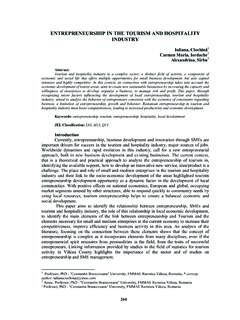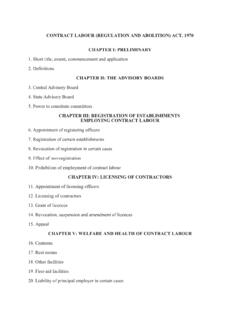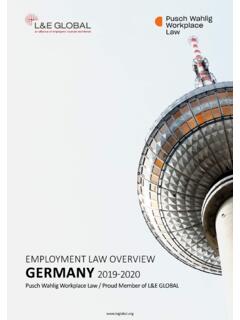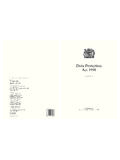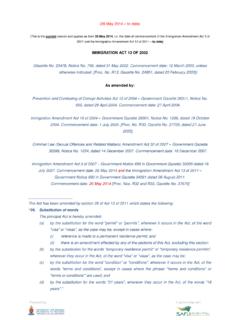Transcription of LABOUR MARKET – CONCEPTS, FUNCTIONS, FEATURES, …
1 201 LABOUR MARKET CONCEPTS, functions , FEATURES, PATTERNS Pa ca Cornelia Serena1 Abstract: In an ever changing world, where economic growth interchanges with crisis, society and economy strategic resource is represented by the human resource (manpower or workforce). This article aims to tackle the presentation of a set of conceptual specifications that would reflect the difference between the labor MARKET and the workforce related MARKET concepts, analyzing the main functions and features of the labor MARKET , as well as the presentation of main training and operational patterns of such MARKET .
2 Keywords: LABOUR MARKET , concepts, features, functions , models JEL Classification: B40, J01 1. THE CONCEPTUALIZATION OF THE LABOUR AND WORKFORCE MARKET There is no universally accepted opinion regarding the use of one of the two phrases; however one has to mention the fact that the use of the term " MARKET " does not mean that LABOUR is behaving like another commodity or service. A simple definition of the LABOUR MARKET is given by Derek Bosworth, Peter Dawkins and Thorsten Stromback (1996) who state that the LABOUR MARKET is the place where supply and demand meet, working to determine the price and quantity of the work performed.
3 Michel Didier (1997) defines the MARKET as a means of communication through which sellers and buyers will inform each other about what they have, what they need and the prices that they ask or propose, before closing the transaction. This definition has great applicability on the LABOUR MARKET . The LABOUR MARKET is the MARKET in which the amount of services that correspond to tasks well established in the job description, are offered for a price or remuneration (Boeri, Van Ours, 2013), that is, to exist on the LABOUR MARKET it is necessary for the work be rewarded. The LABOUR MARKET is and has to be regulated.
4 In the dictionary of LABOUR law (1997), Beligr deanu and Stefanescu (1997) define the LABOUR MARKET as "the confrontation between the supply and demand of LABOUR in a given time frame and a geographic area that is usually completed through employment (with an individual employment contract). The worker (employee) means the person exerts his/hers activity based on an employment contract in a public or private company or institution, receiving in exchange a payment. On the LABOUR MARKET , companies act like buyers on the one hand, but also as bidders with regard to payment, working conditions, and individuals act as sellers, rendering available to employers their knowledge, skills and experience gained.
5 The LABOUR MARKET operates on the principle of competition, the workers competing against each other in view of obtaining or retaining a position. On the other hand, employers compete to attract and maintain within the organizations, the employees that are efficient in the development of the activity and as a result make profit. Authors like Steliana Pert (1990) or Nita Dobrot (1997) consider that the LABOUR MARKET is the economic space in which equity holders trade freely, as buyers (the demand), and the owners of the human resource (the supply), as sellers, in which the price mechanism of the work, the real wage, the free competition between economic operators and other specific mechanisms, adjust the LABOUR supply and demand.
6 First and foremost, employees are not an 1 Phd, Faculty of Economics and Business Administration, Babe Bolyai University, Cluj Napoca, Romania, e-mail 202 abstract production factor, but human beings with families, desires and needs and only then, LABOUR force (Samuelson, Nordhaus, 2001). The LABOUR MARKET is one of the main components of the MARKET economy along with the goods and capital MARKET . From an economic perspective the LABOUR MARKET is one of the components of the production forces (Zamfir & Vl sceanu, 1993).
7 The workforce was and is the "living" factor that gives meaning to the economic life and is the main component of production factors, by whose direct or indirect intervention, all economic activities become possible. In statistical terms, the workforce is represented by the employed population (those working and those actively seeking work) to which the unemployed are added (Schiller, 1983). The result of the buying and selling act is represented by the workforce and not the work itself. Work is just a "consequence" of applying the workforce in production (Eatwel , 1987) which is delivered by the worker and bought by the employer.
8 Among the arguments the authors advocating for the term of workforce MARKET (Adumitr cesei & Niculescu, 1995) we can state that the human factor, who owns the qualification, experience, competence and capacity for working, is the one that constitutes the real object of the transaction and not the salary which is only a means of rewarding the work. Another argument is that in order to obtain goods and services, employers use the workforce and not the work itself. This workforce is different from person to person, each having an efficiency, productivity and different costs. Moreover the social protection is performed with respect to the workforce.
9 It is necessary to distinguish between the work and the individual, that is between what arises from the work process (goods and services) and the individual who possess the skills and knowledge they provide to produce those goods and services. In specialised literature, the LABOUR MARKET is defined from two different points of view. The first is that the work is like any other good or service through which people sell their LABOUR in exchange for wages while the second appreciates the work as a commodity different from the rest of the goods (goods / services) referring rather to the supply of LABOUR available on the LABOUR MARKET (Hudson, 2000).
10 In order for the workforce to become a cargo the following conditions must be met (Popescu, 2002): a) the possibility to be changed with another commodity through and exchange contract; b) giving up the ownership; c) storing in time. Given that the three conditions cannot be fulfilled simultaneously, we will not treat LABOUR as a commodity. Although opinions are divided and because there are still many contradictions in using only one of the two definitions, it seems that the term LABOUR MARKET was often used when the human being was considered a factor of production, because the work was seen as another good.

